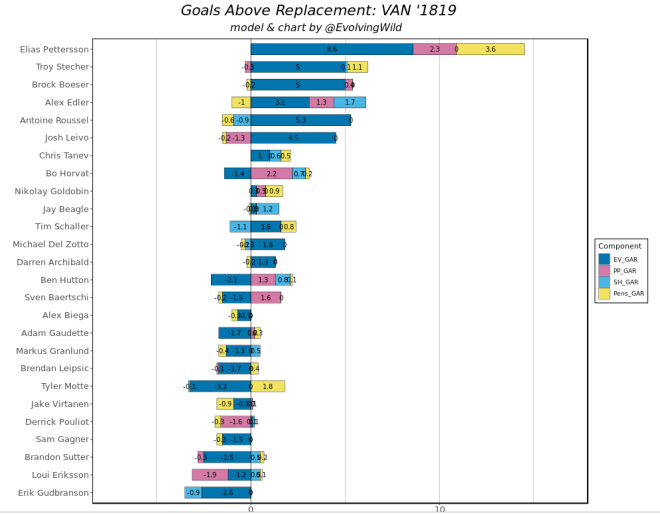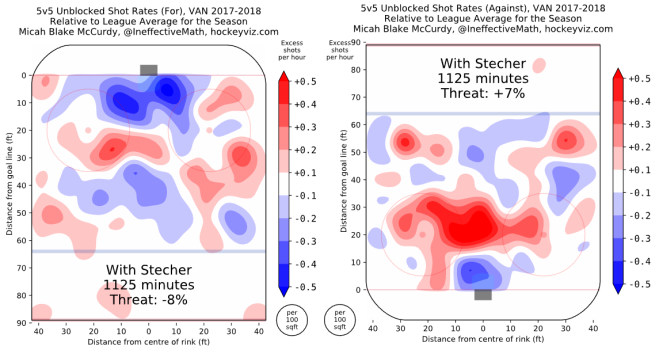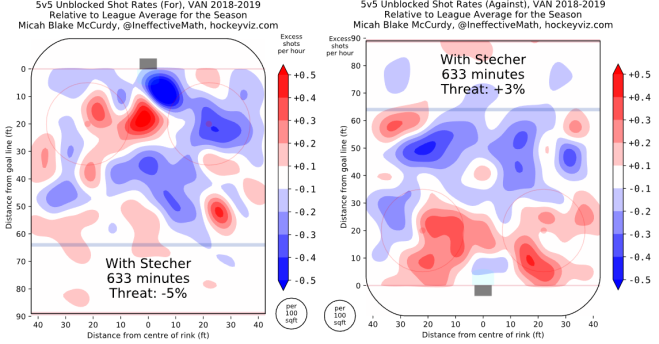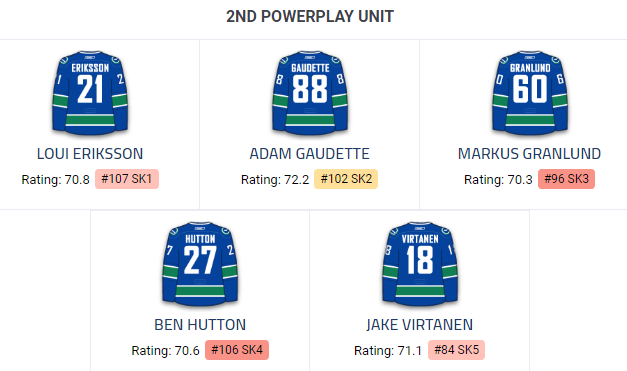Stecher might not be winning the Norris or the Hart this season, but he’s my early pick for one of the toughest trophies to win in hockey: the Canucks Unsung Hero award. This trophy is so exclusive, 90% of the league isn’t even eligible. But Troy is, and he’s my early pick.
Why? Because I wanted an excuse to talk about how actually-good he is.
Stecher was a healthy scratch at one point this season, he sits somewhere in the middle of the totem pole in terms of media coverage and fan chatter, but despite all this Troy from Richmond is putting together an excellent 2018-19 campaign. In just his third season in the NHL, Stecher is establishing himself as a bonafide 3-4 defenceman.
First, let’s take a look at some of his underlying numbers.

Stecher has the best goals-above-replacement on the team of anyone not-named Elias Pettersson. Since he doesn’t get much powerplay time, that production is almost all coming at even strength. He also draws penalties at a good clip (pens_GAR), which is a testament to his style of relentlessly dogging opposition forwards and going deep into the boards.

His points-per-game has recovered to 0.29 from a dip to 0.16 last season. While his expected goals-for (eGF) is down (partially a function of his declining shot rates), so is his e(GA), which translates into a more shut-down defence play-style a la Chris Tanev. Most importantly, *he’s a plus-9 on the season, folks.*
Comparing heat maps of his on-ice shots from hockeyviz.com, it becomes evident that Stecher is doing a better job of generating chances in the opposition’s end and limiting them in the Canucks’ end. If you aren’t familiar with these, the map on the left indicates shots for in the opposition zone, and the map on the right indicates shots against in the Canucks’ zone. Red is more, blue is less.
From 2017-18:

From 2018-19:

The increase in opportunities in the oppositions low slot is significant, as is the decrease in shots against in the Canucks high slot. It appears Stecher is doing a better job of forcing shots to the outside alongside contributing to high-danger opportunities in the opposition zone.
The Pouliot Partnership
Stecher’s most common partner has been Derrick Pouliot this year (296 minutes together at even strength, roughly 60% of his ice time), and he seems to have thrived in this role despite possible challenges. Granted, Pouliot is probably an upgrade from Del Zotto, who shared 37% of his ice time last year, but also a downgrade from Edler, who shared 42% of his ice time.
In a way, this means Stecher is being consistently trusted with more responsibility alongside another young defenceman this year, rather than bouncing back and forth between veterans of varying quality.
Given Pouliot’s propensity for glaring mistakes, a cursory look at the stats for the pairing suggests they haven’t been as bad as one might expect, as demonstrated by NaturalStatTrick’s Line Tool.

They both perform better together, and Pouliot appears to benefit from the pairing perhaps slightly more than Stecher does.
Entertainment Value
To top it all off, he’s fun to watch on the ice. He doggedly attacks opposition forwards when they have the puck and skates like a madman when he has control. He’s forcing guys to the outside and limiting high-danger chances at a good clip. Also, his helmet has fallen off more times than any other Canuck player this season (twice), giving us the bonus visual of his hair whipping around while he plays for his hometown team. His contributions are manifold.
Seriously, look at him go. Are you kidding me?
Beyond performance, sports is all about stories, and Stecher’s is one of the best. Undrafted? Check. Undersized? Check. Local boy? Check. He’s got all the makings of your prototypical underdog fan favourite, and frankly I’ve bought in. He’s also pretty well-spoken, with a charming intensity in interviews (start at 4:18):
Powerplay Ponderings
All that thrown together, I often wonder why the Canucks don’t test him out more as a RHD option on the powerplay. With Green prefering a 4 forward, 1 defenseman setup, he is naturally further down the depth chart than Edler or Hutton, but I can’t help but wonder if this is actually the optimal set up for the second powerplay unit.

It’s no secret that the Canucks’ powerplay unit has struggled. In particular, they have struggled at controlled offensive zone entries, something which Stecher is effective at. Here’s an example of what I mean:
Less of that, please. Why not try a 3 forward, 2 defenceman set up for the second unit powerplay with both Hutton and Stecher on the backend? At very least, he might help PP2 with their nasty habit of conceding short handed goals.
Perhaps swap out Granlund, who as of writing only has 2 more points than Stecher on the season. I’m just throwing stuff at the wall here because I’d like to see what the Richmond Rebel can do on the powerplay, and I do wonder why the Canucks have tried harder to see if there’s a way to slot him in.
Come on Green, just Troy it out.
I like Troy Stecher
We often talk about the dearth of RHD in the Canucks system, but man alive would it look worse if they hadn’t snagged the diligent d-man from UND. This only being his third year in the league, he is developing into a very reliable option on the blue line.
In conclusion, I like Troy Stecher. The only way he loses Unsung Hero this year is if Pettersson sweeps the rest of the team awards and the team feels obliged to give Bo something. But Bo is notably well-sung.
So Stecher going to be my unsung hero pick until he’s completely sung – and even then, I’ll probably want to sing him some more.
